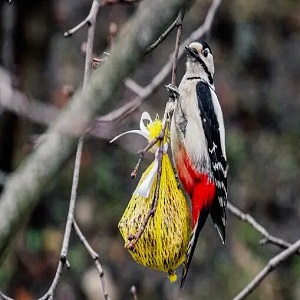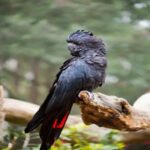Woodpeckers Eat, Woodpeckers are fascinating birds known for their distinctive behavior of pecking at trees and other surfaces. Their diet primarily consists of insects and other small creatures found beneath the bark of trees. In addition to insects, woodpeckers also consume fruits, nuts, and tree sap.
Their specialized adaptations, such as their long, barbed tongues and strong beaks, enable them to forage for food in unique ways. In this article, we will delve deeper into the specific foods that woodpeckers eat and explore how these birds have evolved to thrive on a diverse diet in various environments.
Woodpecker Food Sources: A Varied Menu
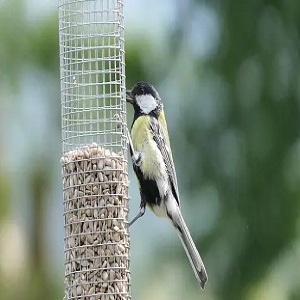
Woodpeckers have a diverse menu that includes insects like ants, beetles, and larvae, which they locate by drumming on tree trunks. They also enjoy tree sap, fruits, nuts, and even occasional small vertebrates. Their specialized adaptations, like long, sticky tongues and strong beaks, make them effective hunters. Woodpeckers play a crucial role in ecosystems by controlling insect populations and dispersing seeds as they forage for their varied food sources.
1. Insects
Insects are a primary food source for woodpeckers, constituting a significant portion of their diet. “Woodpeckers” are adept insect hunters, using their strong beaks and chisel-like tongues to extract insects hidden beneath tree bark. They prey on a wide variety of insects, including ants, beetles, caterpillars, and their larvae.
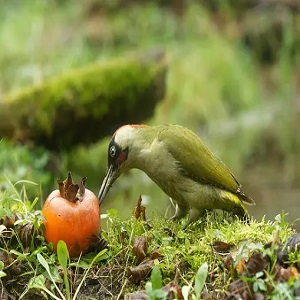
The distinctive drumming sound they create while pecking on tree trunks helps them locate insects by listening to the vibrations they produce. This specialized foraging technique allows woodpeckers to access a consistent and abundant supply of protein-rich insects, making them effective insect control agents in their ecosystems and vital contributors to the balance of local insect populations.
2. Tree Sap
“Tree sap” is another important component of a woodpecker’s diet. These birds have a particular affinity for sap, which provides them with a source of energy and essential nutrients. Woodpeckers often visit sap wells, which are created by drilling holes into tree trunks, where sap oozes out.
They use their specialized tongues, which are equipped with backward-facing barbs, to extract the sap effectively. Sap wells not only provide nourishment for woodpeckers but also attract insects seeking the sugary substance, offering an additional source of food. This strategy showcases the resourcefulness of woodpeckers in utilizing tree sap as a valuable and energy-rich food source in their daily lives.
3. Flower Nectar
While insects and tree sap are primary food sources, some woodpecker species supplement their diet with flower nectar. This behavior is more commonly observed in tropical and subtropical woodpecker species. These birds feed on the nectar of various flowering plants, using their specialized tongues to access the sugary liquid.
By consuming nectar, woodpeckers contribute to pollination, aiding in plant reproduction. This mutually beneficial relationship benefits both woodpeckers and the plants they visit. While flower nectar may not constitute the majority of their diet, it highlights the adaptability of woodpeckers to different food sources, demonstrating their ecological importance as both insectivores and pollinators in certain ecosystems.
4. Fruits
Fruits are another dietary component for woodpeckers, adding variety to their diet. While not a primary food source, woodpeckers do consume a variety of fruits when available. These fruits can include berries, cherries, and other small, fleshy fruits.
Woodpeckers are particularly drawn to fruiting trees and shrubs, where they can pick off and eat the ripe fruit. This occasional fruit consumption provides them with essential vitamins and sugars, especially during seasons when insects may be scarce. Additionally, their fruit-eating behavior can contribute to seed dispersal, aiding in the propagation of plants across their habitats and showcasing the woodpeckers‘ role in ecosystem dynamics.
5. Acorns
Acorns, the nuts produced by oak trees, are a notable dietary preference for some woodpecker species. These birds, particularly the acorn woodpecker, have a special affinity for acorns and are known to store them in tree crevices or other cavities as a winter food cache.
Acorns provide woodpeckers with a rich source of fats and carbohydrates, making them an essential energy source during colder months when insects and other food may be less abundant. Woodpeckers’ habit of storing acorns also plays a role in oak tree ecology, as they may not consume all the acorns they collect, allowing some to germinate and grow into new trees, contributing to the forest’s regeneration.
6. Seeds
While woodpeckers primarily focus on insects, tree sap, fruits, and acorns, some species also incorporate seeds into their diet. Seeds from various plants, including conifers and hardwood trees, are consumed when other food sources are scarce. Woodpeckers may extract seeds from pine cones, berries, or seed pods, using their strong beaks and agile tongues.
This seed consumption serves as a backup food source, ensuring their survival during lean times. Additionally, their feeding behavior can play a role in forest dynamics, as they may inadvertently aid in seed dispersal, promoting the growth of new vegetation and contributing to the ecological balance of their habitats.
7. Lizards and Salamanders
While insects and plant-based foods dominate their diet, certain woodpecker species occasionally consume small vertebrates like lizards and salamanders. This behavior is more commonly observed in larger woodpecker species such as the Northern Flicker. Woodpeckers may catch these small reptiles and amphibians on the ground or among vegetation while foraging.
Their strong bills and quick strikes make them effective hunters for such prey. However, vertebrates make up a relatively small portion of their diet compared to insects and other foods. This opportunistic behavior highlights the adaptability of woodpeckers in finding sustenance in various forms within their diverse ecosystems.
8. Birds and Eggs
While woodpeckers eat are primarily insectivores, they occasionally target other birds and their eggs as a food source. This behavior is more common in larger woodpecker species like the Northern Flicker and the Ivory-billed Woodpecker. They may raid the nests of smaller birds, particularly cavity-nesting species, and consume both eggs and nestlings. Their strong bills enable them to break into nests and extract their prey.
However, bird predation is relatively rare in woodpeckers and constitutes a small portion of their diet. This opportunistic feeding behavior occurs mostly when insects and other preferred food sources are scarce, underscoring their adaptability in finding sustenance in various ecological conditions.
Small Black Birds With White Bellies: Meet 15 Fascinating Species
Drumming and Eating: What’s the Connection?
Drumming and eating are two interconnected behaviors in woodpeckers. The “drumming” sound, produced by rapidly pecking on tree trunks and other surfaces, serves multiple purposes.
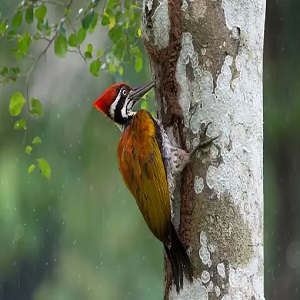
Firstly, it helps woodpeckers locate hidden insects by listening to the vibrations they create within the wood. Secondly, it establishes territory and communicates with other woodpeckers, particularly during the breeding season.
Once insects are detected through drumming, woodpeckers use their specialized beaks and barbed tongues to extract them from beneath the bark. In essence, drumming is the key that unlocks their primary food source, making it an essential part of their foraging strategy and communication within their habitat.
How To Attract Woodpeckers With Food
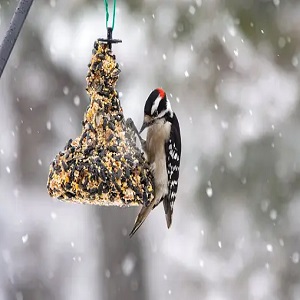
Woodpeckers are fascinating birds with their unique drumming and acrobatic skills. They are also beneficial to the environment, as they help to control populations of insects and pests. If you would like to attract woodpeckers to your yard, there are a few things you can do:
Offer high-energy food. Woodpeckers need a lot of energy to maintain their active lifestyle. Some of their favorite foods include:
- Suet
- Peanuts
- Black oil sunflower seeds
- Insect jelly
- Fruit (such as apples, oranges, and berries)
You can offer these foods in a variety of ways, such as in suet feeders, platform feeders, or simply placed on a tree trunk or other surface.
Place feeders in a safe location. Woodpeckers are shy birds, so they prefer to feed in areas where they feel safe. Place your feeders in a quiet spot, away from predators and heavy traffic. You may also want to consider placing your feeders near trees or shrubs, so that woodpeckers have a place to perch and rest.
Provide a water source. Woodpeckers need water to drink and bathe in. Place a shallow dish of water in your yard, near your feeders. You may also want to consider adding a birdbath.
Be patient. It may take some time for woodpeckers to find your feeders. Once they discover your yard, they are likely to become regular visitors.
Here are some additional tips for attracting woodpeckers to your yard:
- Leave dead trees standing. Woodpeckers use dead trees for nesting and foraging for food.
- Plant native trees and shrubs. Woodpeckers are attracted to native plants, as they provide them with food and shelter.
- Avoid using pesticides in your yard. Pesticides can kill the insects that woodpeckers eat.
10 Common Woodpecker Species and Diet Specifics
1. Downy Woodpeckers Eat
Downy Woodpeckers (Picoides pubescens) are small, black-and-white woodpecker species found throughout North America. They are easily recognizable by their white undersides, black wings marked with white spots, and a distinct white stripe on their head. These birds primarily feed on insects, seeds, and fruits and are common visitors to backyard bird feeders.
2. Hairy Woodpeckers
Hairy Woodpeckers (Picoides villosus) closely resemble Downy Woodpeckers but are slightly larger. They are also found in North America and share a similar black-and-white plumage pattern. Hairy Woodpeckers primarily feed on insects and tree sap, often foraging on tree trunks and branches. They are known for their drumming behavior and are commonly spotted in woodlands and suburban areas across their range.
3. Northern Flickers
Northern Flickers (Colaptes auratus) are medium-sized woodpeckers with distinctive markings. They have brownish-gray plumage with black markings on their chest and a prominent white rump patch. Unlike many woodpeckers, Northern Flickers are often seen foraging on the ground for insects, particularly ants. They also consume fruits and seeds, making them diverse feeders.
4. Pileated Woodpeckers
Pileated Woodpeckers (Dryocopus pileatus) are the largest woodpecker species in North America. They feature striking black bodies with white stripes and a prominent red crest on their heads. Pileated Woodpeckers primarily feed on insects and tree sap, often creating large, rectangular excavations in tree trunks during foraging.
5. Red-Bellied Woodpeckers
Red-bellied Woodpeckers (Melanerpes carolinus) have distinctive red caps on their heads. Contrary to their name, their bellies are only faintly red. These woodpeckers primarily eat insects, seeds, and fruits, and they are known for their adaptable foraging behavior, frequently visiting bird feeders.
6. Yellow-Bellied Sapsuckers
Yellow-bellied Sapsuckers (Sphyrapicus varius) are migratory woodpeckers with unique habits. They create sap wells on trees to feed on the sugary sap and insects attracted to it. They also consume fruits and insects. Their distinctive markings include a yellow belly and a red crown on males.
7. Red-Headed Woodpeckers
Red-headed Woodpeckers (Melanerpes erythrocephalus) are striking birds with entirely red heads and white bodies. They primarily feed on insects, fruits, and nuts and are known for their caching behavior, storing food in tree crevices.
8. Lewis’s Woodpeckers
Lewis’s Woodpeckers (Melanerpes lewis) have a distinctive dark plumage and a pinkish-red belly. They are often found in open woodlands and savannahs.
9. White Woodpeckers
I’m not aware of a woodpecker species commonly referred to as “White Woodpeckers.” It’s possible that you may be referring to a specific subspecies or a less commonly known species.
10. Red-Breasted Sapsuckers
Red-breasted Sapsuckers (Sphyrapicus ruber) have red throats and heads. These woodpeckers feed on sap from tree wells they create, along with insects and fruits.
How Do Woodpeckers Hunt Their Food?
Woodpeckers have evolved specialized hunting techniques that enable them to find and capture their diverse range of food sources:
- Drumming: Woodpeckers produce rhythmic drumming sounds by pecking on tree trunks, which serves as a means to locate insects hidden beneath the bark. They listen for vibrations that insects create as they move within the wood.
- Probing: Woodpeckers use their strong, chisel-like beaks to probe into crevices, cracks, and tree bark to extract insects, larvae, and eggs. Their bills are adapted to penetrate wood and extract prey efficiently.
- Tongue Adaptations: Woodpeckers have long, extensible tongues equipped with backward-facing barbs or bristles. These specialized tongues help them grasp and extract insects from deep inside tree crevices.
- Sap Wells: Some woodpecker species, like Sapsuckers, create sap wells by drilling holes in trees to access sap and insects attracted to it. They then use their tongue to lap up the sap.
- Ground Foraging: Species like the Northern Flicker forage on the ground for ants, which are a primary part of their diet.
- Opportunistic Hunting: Woodpeckers also exhibit opportunistic behavior, occasionally consuming fruits, nuts, seeds, and even small vertebrates when available.
The Woodpeckers In NC: 8 Fascinating Types, Facts, & Habitat
What Do Baby Woodpeckers Eat?
Baby woodpeckers, like their adult counterparts, have specialized dietary needs to support their growth and development. Their diet typically evolves as they mature:
- Nesting Stage (Hatchlings to Fledglings): During the early stages of their life, baby woodpeckers are primarily fed a diet of regurgitated insects by their parents. The adult woodpeckers collect insects like beetles, ants, and larvae to provide a protein-rich diet for their hungry offspring.
- Transition to Solid Food: As the baby woodpeckers grow and develop, they begin to transition to a diet more similar to that of adult woodpeckers. They start to peck at insects and larvae found on and beneath the bark of trees.
- Exploring a Varied Diet: Depending on the woodpecker species and their environment, young woodpeckers may also consume fruits, berries, and seeds as they learn to forage on their own.
- Learning from Parents: Parental guidance plays a significant role in teaching young woodpeckers how to hunt for insects, forage for food, and use their specialized beaks and tongues effectively.
Overall, the diet of baby woodpeckers is a combination of insects initially provided by their parents and the gradual incorporation of solid foods they learn to find and capture as they mature. This process ensures their nutritional needs are met as they grow into skilled foragers.
What Do Woodpeckers Eat During Winter?
Woodpeckers face unique challenges in finding food during the winter months, but they have adapted strategies to cope with these harsh conditions:
- Insects: While insects are less active in cold weather, woodpeckers continue to search for them beneath the bark of trees. They exploit crevices and woodpecker-created holes where insects might seek refuge, ensuring a steady supply of protein.
- Tree Sap: Woodpeckers rely more on tree sap in winter when insect availability decreases. Sap remains a consistent source of energy, and they continue to visit sap wells created earlier in the year.
- Fruits and Berries: Some woodpecker species shift to a fruit-based diet during the winter. They feed on berries, apples, and other fruits that persist on trees and shrubs. These fruits provide essential carbohydrates and energy.
- Nuts: Nuts, like acorns, are another important winter food source for woodpeckers. They often store acorns and nuts in tree crevices or feed on those left behind by other animals.
- Bird Feeders: In suburban areas, woodpeckers may visit backyard bird feeders for seeds, suet, and other winter offerings.
Woodpeckers’ adaptability and varied diet allow them to survive winter by switching between these food sources, ensuring they have the energy needed to endure the cold and maintain their health until spring brings a resurgence of insects.
FAQs:
What is the primary diet of woodpeckers?
This question addresses the core of a woodpecker’s diet, focusing on the types of food they predominantly consume.
Do different species of woodpeckers have varied diets?
This question explores whether woodpecker species exhibit dietary variations and if certain types of woodpeckers prefer specific foods.
How do woodpeckers find and capture their food?
This question delves into the hunting and foraging techniques woodpeckers employ to locate and obtain their meals.
What are some common insects and other food sources for woodpeckers?
This question seeks to identify some of the specific insects, larvae, and other natural food sources that woodpeckers rely on for sustenance.
Do woodpeckers eat anything besides insects and wood-boring larvae?
This question investigates whether woodpeckers incorporate any other dietary items beyond insects and tree-dwelling larvae into their nutrition.
